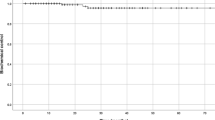Abstract
Purpose
There are no safety-focused trials on stereotactic body radiotherapy (SBRT) for localized prostate cancer. This prospective 3‑year phase II trial used binomial law to validate the safety and efficacy of SBRT with stringent organ at risk dose constraints that nevertheless permitted high planning target volume doses.
Methods
All consecutive ≥ 70-year-old patients with localized prostate adenocarcinoma who underwent SBRT between 2014 and 2018 at the National Radiotherapy Center in Luxembourg were included. Patients with low Cancer of Prostate Risk Assessment (CAPRA) scores (0–2) and intermediate scores (3–5) received 36.25 Gy. High-risk (6–10) patients received 37.5 Gy. Radiation was delivered in 5 fractions over 9 days with Cyberknife-M6™ (Accuray, Sunnyvale, CA, USA). Primary study outcome was Common Terminology Criteria for Adverse Events version 4 (CTCAEv4) genitourinary and rectal toxicity scores at last follow-up. Based on binomial law, SRBT was considered safe in this cohort of 110 patients if there were ≤ 2 severe toxicity (CTCAEv4 grade ≥ 3) cases. Secondary outcomes were biochemical progression-free survival (bPFS) and patient quality of life (QOL), as determined by the IPPS and the Urinary Incontinence QOL questionnaire.
Results
The first 110 patients who were accrued in a total cohort of 150 patients were included in this study and had a median follow-up of 36 months. Acute grade ≥ 3 toxicity never occurred. One transient late grade 3 case was observed. Thus, our SBRT program had an estimated severe toxicity rate of < 5% and was safe at the p < 0.05 level. Overall bPFS was 90%. QOL did not change relative to baseline.
Conclusion
The trial validated our SBRT regimen since it was both safe and effective.



Similar content being viewed by others
References
Dearnaley D, Syndikus I, Mossop H et al (2016) Conventional versus hypofractionated high-dose intensity-modulated radiotherapy for prostate cancer : 5‑year outcomes of the randomised , non-inferiority , phase 3 CHHiP trial. Lancet Oncol 17(8):1047–1060. https://doi.org/10.1016/S1470-2045(16)30102-4
Catton CN, Lukka H, Gu CS et al (2017) Randomized trial of a hypofractionated radiation regimen for the treatment of localized prostate cancer. J Clin Oncol 35(17):1884–1890. https://doi.org/10.1200/JCO.2016.71.7397
Incrocci L, Wortel RC, Alemayehu WG et al (2016) Hypofractionated versus conventionally frationated radiotherapy for patients with localised prostate cancer ( HYPRO ): final efficacy results from a randomised , multicentre , open-label , phase 3 trial. Lancet Oncol 2045(16):1–9. https://doi.org/10.1016/S1470-2045(16)30070-5
Demanes DJ, Martinez AA, Ghilezan M et al (2011) High-dose-rate monotherapy: safe and effective brachytherapy for patients with localized prostate cancer. Int J Radiat Oncol Biol Phys 81(5):1286–1292. https://doi.org/10.1016/j.ijrobp.2010.10.015
Barkati M, Williams SG, Foroudi F et al (2012) High-dose-rate brachytherapy as a monotherapy for favorable-risk prostate cancer: a phase II trial. Int J Radiat Oncol Biol Phys 82(5):1889–1896. https://doi.org/10.1016/j.ijrobp.2010.09.006
Morgan SC, Hoffman K, Loblaw DA et al (2018) Hypofractionated radiation therapy for localized prostate cancer: an ASTRO, ASCO, and AUA evidence-based guideline. J Clin Oncol 36(34):3411–3430. https://doi.org/10.1200/JCO.18.01097
King CR, Freeman D, Kaplan I et al (2013) Stereotactic body radiotherapy for localized prostate cancer : pooled analysis from a multi-institutional consortium of prospective phase II trials. Radiother Oncol 109(2):217–221. https://doi.org/10.1016/j.radonc.2013.08.030
Meier RM, Bloch DA, Cotrutz C et al (2018) Multicenter trial of stereotactic body radiation therapy for low- and intermediate-risk prostate cancer : survival and toxicity endpoints. Int J Radiat Oncol Biol Phys 102(2):296–303. https://doi.org/10.1016/j.ijrobp.2018.05.040
Alayed Y, Cheung P, Pang G et al (2018) Dose escalation for prostate stereotactic ablative radiotherapy (SABR): late outcomes from two prospective clinical trials. Radiother Oncol 127(2):213–218. https://doi.org/10.1016/j.radonc.2018.03.005
Kishan AU, Dang A, Katz AJ et al (2019) Long-term outcomes of Stereotactic body radiotherapy for low-risk and intermediate-risk prostate cancer. JAMA Netw Open 2(2):1–13. https://doi.org/10.1001/jamanetworkopen.2018.8006
Katz A, Kang J (2014) Stereotactic body radiotherapy as treatment for organ confined low and intermediate risk prostate carcinoma, a seven year study. Front Oncol. https://doi.org/10.3389/fonc.2014.00240
Jackson WC, Silva J, Hartman HE et al (2019) Stereotactic body radiation therapy for localized prostate cancer: a systematic review and meta-analysis of over 6,000 patients treated on prospective studies. Int J Radiat Oncol Biol Phys 104(4):778–789. https://doi.org/10.1016/j.ijrobp.2019.03.051
Widmark A, Gunnlaugsson A, Beckman L et al (2019) Ultra-hypofractionated versus conventionally fractionated radiotherapy for prostate cancer: 5‑year outcomes of the HYPO-RT-PC randomised, non-inferiority, phase 3 trial. Lancet 394(10196):385–395. https://doi.org/10.1016/S0140-6736(19)31131-6
Brand DH, Tree AC, Ostler P et al (2019) Intensity-modulated fractionated radiotherapy versus stereotactic body radiotherapy for prostate cancer (PACE-B): acute toxicity findings from an international, randomised, open-label, phase 3, non-inferiority trial. Lancet Oncol 20(11):1531–1543. https://doi.org/10.1016/S1470-2045(19)30569-8
Viani GA, Stefano EJ, Afonso SL (2009) Higher-than-conventional radiation doses in localized prostate cancer treatment: a meta-analysis of randomized, controlled trials. Int J Radiat Oncol Biol Phys 74(5):1405–1418. https://doi.org/10.1016/j.ijrobp.2008.10.091
Heemsbergen WD, Al-Mamgani A, Slot A, Dielwart MFH, Lebesque JV (2014) Long-term results of the Dutch randomized prostate cancer trial: Impact of dose-escalation on local, biochemical, clinical failure, and survival. Radiother Oncol 110(1):104–109. https://doi.org/10.1016/j.radonc.2013.09.026
Peeters STH, Heemsbergen WD, Van Putten WLJ et al (2005) Acute and late complications after radiotherapy for prostate cancer: Results of a multicenter randomized trial comparing 68 Gy to 78 Gy. Int J Radiat Oncol Biol Phys 61(4):1019–1034. https://doi.org/10.1016/j.ijrobp.2004.07.715
Parker CC, James ND, Brawley CD et al (2018) Articles Radiotherapy to the primary tumour for newly diagnosed, metastatic prostate cancer (STAMPEDE): a randomised controlled phase 3 trial. Lancet 392(10162):2353–2366. https://doi.org/10.1016/S0140-6736(18)32486-3
Dearnaley DP, Sydes MR, Langley RE et al (2007) The early toxicity of escalated versus standard dose conformal radiotherapy with neo-adjuvant androgen suppression for patients with localised prostate cancer: Results from the MRC RT01 trial (ISRCTN47772397). Radiother Oncol 83(1):31–41. https://doi.org/10.1016/j.radonc.2007.02.014
Matzinger O, Duclos F, van den Bergh A et al (2009) Acute toxicity of curative radiotherapy for intermediate- and high-risk localised prostate cancer in the EORTC trial 22991. Eur J Cancer 45(16):2825–2834. https://doi.org/10.1016/j.ejca .2009.07.009
Zelefsky MJ, Chan H, Hunt M, Yamada Y, Shippy AM, Amols H (2006) Long-term outcome of high dose intensity modulated radiation therapy for patients with clinically localized prostate cancer. J Urol 176(4):1415–1419. https://doi.org/10.1016/j.juro.2006.06.002
Cooperberg MR, Pasta DJ, Elkin EP et al (2005) The university of California, san Francisco cancer of the prostate risk assessment score: a straightforward and reliable preoperative predictor of disease recurrence after radical prostatectomy. J Urol 173(6):1938–1942. https://doi.org/10.1097/01.ju.0000158155.33890.e7
Wilke L, Andratschke N, Blanck O et al (2019) ICRU report 91 on prescribing, recording, and reporting of stereotactic treatments with small photon beams: Statement from the DEGRO/DGMP working group stereotactic radiotherapy and radiosurgery. Strahlenther Onkol 195(3):193–198. https://doi.org/10.1007/s00066-018-1416-x
Roach M, Hanks G, Thames H et al (2006) Defining biochemical failure following radiotherapy with or without hormonal therapy in men with clinically localized prostate cancer: recommendations of the RTOG-ASTRO Phoenix Consensus Conference. Int J Radiat Oncol Biol Phys 65(4):965–974. https://doi.org/10.1016/j.ijrobp.2006.04.029
Loi M, Wortel RC, Francolini G, Incrocci L (2019) Sexual function in patients treated with stereotactic radiotherapy for prostate cancer : a systematic review of the current evidence selection criteria and search strategy validity of included studies. J Sex Med 16(9):1409–1420. https://doi.org/10.1016/j.jsxm.2019.05.019
Royce TJ, Mavroidis P, Wang K et al (2021) Tumor control probability modeling and systematic review of the literature of stereotactic body radiation therapy for prostate cancer. Int J Radiat Oncol Biol Phys 110(1):227–236. https://doi.org/10.1016/j.ijrobp.2020.08.014
Wang K, Mavroidis P, Royce TJ et al (2021) Prostate stereotactic body radiation therapy: an overview of toxicity and dose response. Int J Radiat Oncol Biol Phys 110(1):237–248. https://doi.org/10.1016/j.ijrobp.2020.09.054
Mahase SS, D’Angelo D, Kang J, Hu JC, Barbieri CE, Nagar H (2020) Trends in the use of stereotactic body radiotherapy for treatment of prostate cancer in the United States. JAMA Netw Open 3(2):1–12. https://doi.org/10.1001/jamanetworkopen.2019.20471
Bolzicco G, Favretto MS, Satariano N, Scremin E, Tambone C, Tasca A (2013) A single-center study of 100 consecutive patients with localized prostate cancer treated with stereotactic body radiotherapy. BMC Urol 13(1):1. https://doi.org/10.1186/1471-2490-13-49
Tree AC, Ostler P, Hoskin P et al (2014) Prostate stereotactic body radiotherapy—first UK experience. Clin Oncol 26(12):757–761. https://doi.org/10.1016/j.clon.2014.08.007
Koskela K, Palmgren JE, Heikkilä J et al (2017) Hypofractionated stereotactic body radiotherapy for localized prostate cancer-first Nordic clinical experience. Acta Oncol 56(7):978–983. https://doi.org/10.1080/0284186X.2017.1288923
D’Agostino G, Franzese C, De Rose F et al (2016) High-quality linac-based stereotactic body radiation therapy with flattening filter free beams and volumetric modulated arc therapy for low-intermediate risk prostate cancer. A mono-institutional experience with 90 patients. Clin Oncol 28(12):e173–e178. https://doi.org/10.1016/j.clon.2016.06.013
Glowacki G, Majewski W, Wojcieszek P, Grabinska K, Wozniak G, Miszczyk L (2017) Ultrahypofractionated CyberKnifeTM based stereotactic radiotherapy versus conventional radiotherapy in patients with prostate cancer—acute toxicity evaluation in two phase II prospective studies. Neoplasma. https://doi.org/10.4149/neo_2017_421
Acknowledgements
We are grateful to the clinical staff of the Centre François Baclesse, namely Dr Louis Céline, Dr Philippi Sven, Dr Biver Sylvie, Dr Frédérique Bérangère, and Zsusa Bodgal, for monitoring the clinical data. We also thank Prof. Adelin Albert from Liège University in Belgium for the binomial law statistical concept.
Funding
No funds, grants, or other support was received.
Author information
Authors and Affiliations
Contributions
All authors contributed to study conception and design. Material preparation, data collection, and analysis were performed by Paul Nguyen, Philippe Nickers, Ludovic Harzée, Stéphane Joseph, Paul Rétif, and Guillaume Vogin. The first draft of the manuscript was written by Paul Nguyen and all authors commented on previous versions of the manuscript. All authors read and approved the final manuscript.
Corresponding author
Ethics declarations
Conflict of interest
P. Nguyen, L. Harzée, P. Retif, S. Joseph, G. Vogin, and P. Nickers declare that they have no competing interests.
Ethical standards
All procedures performed in studies involving human participants or on human tissue were in accordance with the ethical standards of the institutional and/or national research committee (National Review Board of Luxembourg (approval no. 201311/01)) and with the 1975 Helsinki declaration and its later amendments or comparable ethical standards. Informed consent was obtained from all individual participants included in the study.
Additional information
Availability of data and material
Data and materials are available upon reasonable request.
Code availability
Codes are available upon reasonable request.
Rights and permissions
About this article
Cite this article
Nguyen, P., Harzée, L., Retif, P. et al. Prospective validation of stringent dose constraints for prostatic stereotactic radiation monotherapy: results of a single-arm phase II toxicity-oriented trial. Strahlenther Onkol 197, 1001–1009 (2021). https://doi.org/10.1007/s00066-021-01832-y
Received:
Accepted:
Published:
Issue Date:
DOI: https://doi.org/10.1007/s00066-021-01832-y




